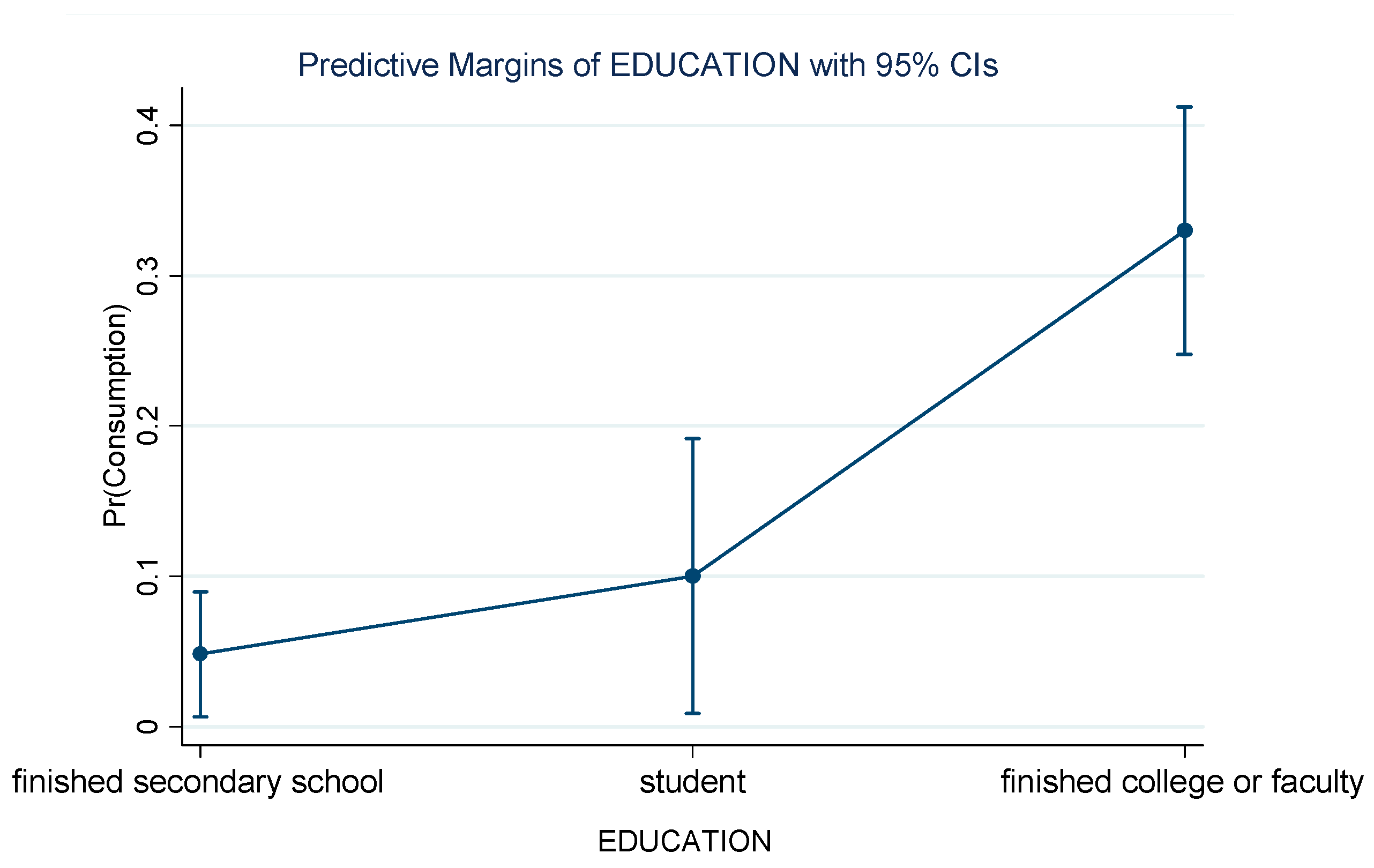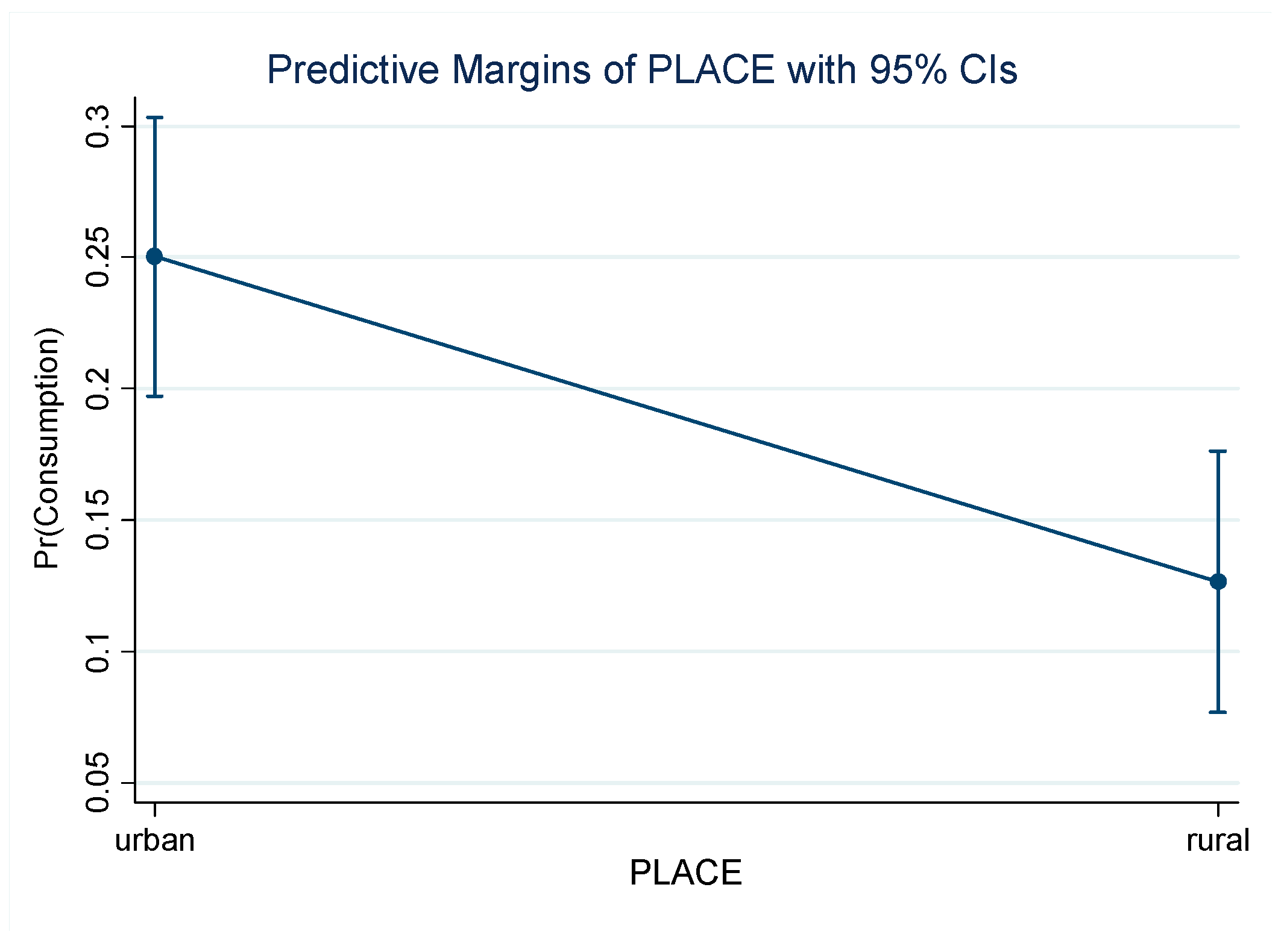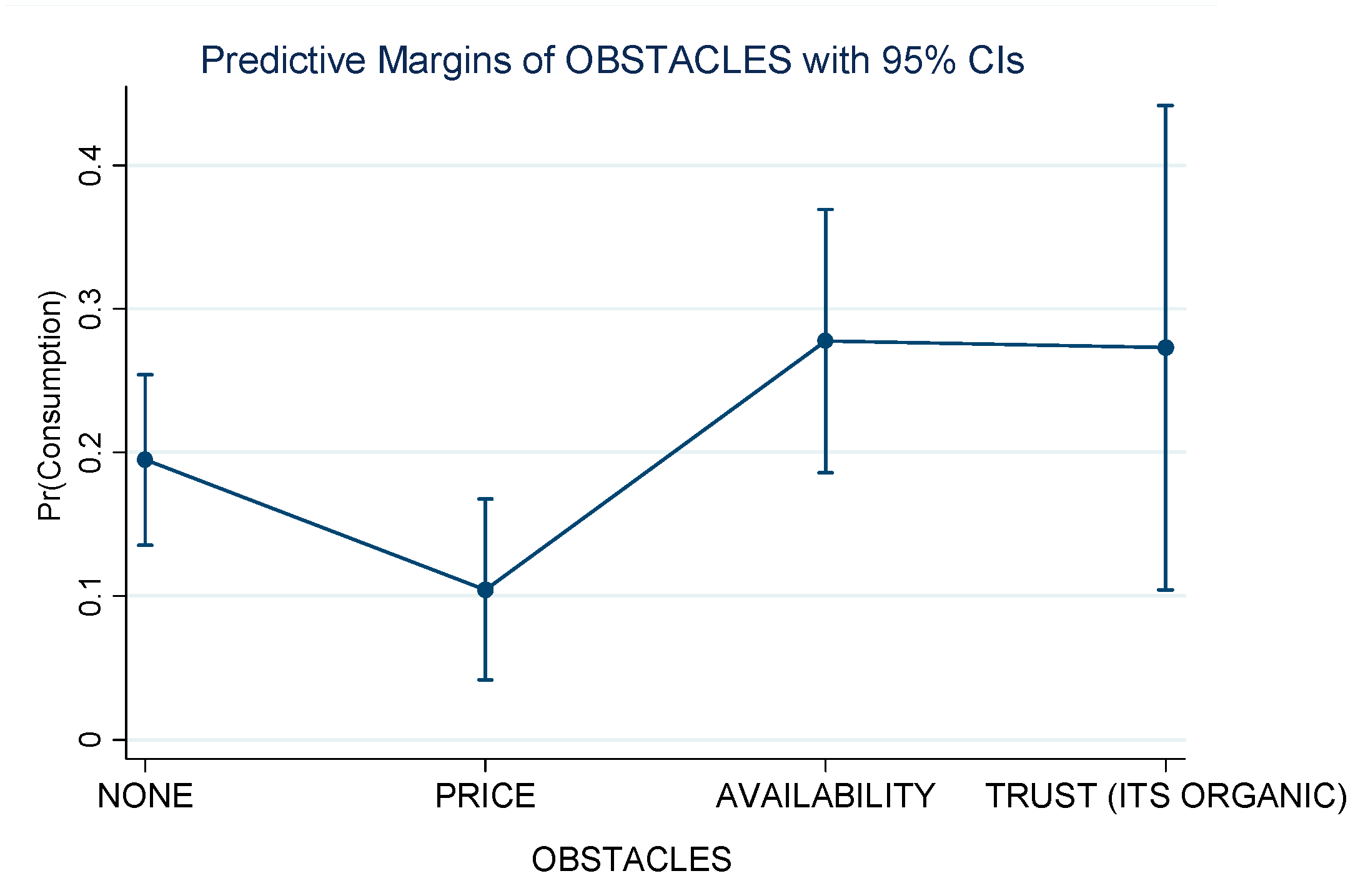Serbian Organic Food Consumer Research and Bioeconomy Development
Abstract
:1. Introduction
2. Literature Review
2.1. The Bioeconomy
- A biotechnology vision, where the focus is on the research, application, and commercialization of biotechnologies in various sectors;
- A bioresource vision, where the focus is on the use and availability of biological resources, as well as on the development of new value chains; and
- A bioecology vision, where the emphasis is on the ecological processes related to energy and nutrients optimization, biodiversity promotion, avoiding monocultures, and the prevention of soil degradation.
- Sustainable capital, characterized by an industrial (bio)technology and the continuation of capitalist expansion, with the key role of technology in all narratives;
- Eco-growth, characterized by agroecology and the capitalist growth economy, with a focus on organic entrepreneurship, small-scale farming, agroecological innovation, and a regional aspect;
- Eco-retreat, combining socioeconomic sufficiency on the one side, and a devotion to ecological agriculture, fishery, and forestry practices on the other; and
- Planned transition, combining a sufficient narrative and industrial (bio)technology.
2.2. The Bioeconomy and Organic Food
2.3. Organic Food Consumer Profile Research
3. Methodology
4. Results
5. Discussion and Conclusions
Author Contributions
Funding
Conflicts of Interest
References
- Bugge, M.M.; Hansen, T.; Klitkou, A. What Is the Bioeconomy? A Review of the Literature. Sustainability 2016, 8, 691. [Google Scholar] [CrossRef]
- Patermann, C.; Aguilar, A. The origins of the bioeconomy in the European Union. New Biotechnol. 2017, 40, 20–24. [Google Scholar] [CrossRef] [PubMed]
- Kircher, M. The transition to a bio-economy: National perspectives. Biofuels Bioproducts Biorefining 2012, 6, 240–245. [Google Scholar] [CrossRef]
- Canja, C.M.; Boeriu, A.E.; Măzărel, A. Bioeconomy and food safety security. In Proceedings of the 7th International Conference on Computational Mechanics and Virtual Engineering, COMEC 2017, Brasov, Romania, 16–17 November 2017. [Google Scholar]
- Willer, H.; Lernoud, J. The World of Organic Agriculture—Statistics and Emerging Trends 2018; Research Institute of Organic Agriculture FiBL: Frick, Switzerland; Organics International IFOAM: Bonn, Germany, 2018; pp. 1–348. ISBN 978-3-03736-068-2. [Google Scholar]
- Simic, I. Organic Agriculture in Serbia At a Glance 2017; National Association Serbia Organica: Belgrade, Serbia, 2017; pp. 1–59. ISBN 978-86-88997-09-6.
- Hughner, R.S.; McDonagh, P.; Prothero, A.; Shultz, C.J.; Stanton, J. Who are organic food consumers? A compilation and review of why people purchase organic food. J. Consum. Behav. 2007, 6, 94–110. [Google Scholar] [CrossRef]
- Djokic, N.; Grubor, A.; Milicevic, N.; Petrov, V. New Market Segmentation Knowledge in the Function of Bioeconomy Development in Serbia. Amfiteatru Econ. 2018, 20, 700–716. [Google Scholar] [CrossRef]
- Grubor, A.; Djokic, N. Organic food consumer profile in the Republic of Serbia. Br. Food J. 2016, 118, 164–182. [Google Scholar] [CrossRef]
- Sillanpää, M.; Ncibi, C. A Sustainable Bioeconomy: The Green Industrial Revolution; Springer: Cham, Switzerland, 2017; pp. 1–343. ISBN 978-3-319-55637-6. [Google Scholar]
- Staffas, L.; Gustavsson, M.; McCormick, K. Strategies and Policies for the Bioeconomy and Bio-Based Economy: An Analysis of Official National Approaches. Sustainability 2013, 5, 2751–2769. [Google Scholar] [CrossRef] [Green Version]
- Regional Bioeconomy Profiles Including Socio-Economic and Environmental Impacts: Two Case Studies. Available online: http://www.bio-step.eu/fileadmin/BioSTEP/Bio_documents/BioSTEP_D6.1_Regional_bioeconomy_profiles.pdf (accessed on 1 October 2018).
- European Commission. Communication from the Commission to the European Parliament, the Council, the European Economic and Social Committee and the Committee of the Regions: Innovating for Sustainable Growth: A Bioeconomy for Europe; European Commission: Brussels, Belgium, 2012. [Google Scholar]
- Ahmed, E.M. Are bio-economy dimensions new stream of the knowledge economy? World J. Sci. Technol. Sustain. Dev. 2017, 15, 142–155. [Google Scholar] [CrossRef]
- Asada, R.; Stern, T. Competitive Bioeconomy? Comparing Bio-based and Non-bio-based Primary Sectors of the World. Ecol. Econ. 2018, 149, 120–128. [Google Scholar] [CrossRef]
- Hausknost, D.; Schriefl, E.; Lauk, C.; Kalt, G. A Transition to Which Bioeconomy? An Exploration of Diverging Techno-Political Choices. Sustainability 2017, 9, 669. [Google Scholar] [CrossRef]
- Rosegrant, M.W.; Ringler, C.; Zhu, T.; Tokgoz, S.; Bhandary, P. Water and food in the bioeconomy: Challenges and opportunities for development. Agric. Econ. 2013, 44, 139–150. [Google Scholar] [CrossRef]
- Bell, J.; Lino, P.; Dodd, T.; Németh, S.; Nanou, C.; Mega, V.; Campos, P. EU ambition to build the world’s leading bioeconomy—Uncertain times demand innovative and sustainable solutions. New Biotechnol. 2018, 40, 25–30. [Google Scholar] [CrossRef] [PubMed]
- Schmidt, O.; Padel, S.; Levidow, L. The Bio-Economy Concept and Knowledge Base in a Public Goods and Farmer Perspective. Bio-Based Appl. Econ. 2012, 1, 47–64. [Google Scholar] [CrossRef]
- Đokić, N.; Milićević, N. Organic consumer profile and obstacles for increasing consumption of organic food in Serbia. Ann. Faculty Econ. Subotica 2016, 53, 65–77. [Google Scholar]
- Vehapi, S.; Dolićanin, E. Consumers behavior on organic food: Evidence from the Republic of Serbia. Econ. Agric. 2016, 63, 871–889. [Google Scholar] [CrossRef]
- Perić, N.; Vasić-Nikčević, A.; Vujić, N. Consumers attitudes on organic food in Serbia and Croatia: A comparative analysis. Econ. Agric. 2017, 64, 1049–1064. [Google Scholar] [CrossRef] [Green Version]
- Vapa-Tankosić, J.; Ignjatijević, S.; Kranjac, M.; Lekić, S.; Prodanović, R. Willingness to pay for organic products on the Serbian market. Int. Food Agribus. Manag. Rev. 2018, 21, 791–801. [Google Scholar] [CrossRef]
- Zepeda, L.; Li, J. Characteristics of organic food shoppers. J. Agric. Appl. Econ. 2007, 39, 17–28. [Google Scholar] [CrossRef]
- Cicia, G.; Del Giudice, T.; Scarpa, R. Consumers’ perception of quality in organic food: A random utility model under preference heterogeneity and choice correlation from rank-orderings. Br. Food J. 2002, 104, 200–213. [Google Scholar] [CrossRef]
- Sandalidou, E.; Baourakis, G.; Siskos, Y. Customers’ perspectives on the quality of organic olive oil in Greece: А satisfaction evaluation approach. Br. Food J. 2002, 104, 391–406. [Google Scholar] [CrossRef]
- Loureiro, M.L.; Hine, S. Discovering niche markets: A comparison of consumer willingness to pay for a local (Colorado-grown), organic, and GMO-free product. J. Agric. Appl. Econ. 2002, 34, 477–487. [Google Scholar] [CrossRef]
- Gracia, A.; de Magistris, T. Organic food product purchase behaviour: А pilot study for urban consumers in the South of Italy. Span. J. Agric. Res. 2007, 5, 439–451. [Google Scholar] [CrossRef]
- Stolz, H.; Stolze, M.; Janssen, M.; Hamm, U. Preferences and determinants for organic, conventional and conventional-plus products—The case of occasional organic consumers. Food Qual. Prefer. 2011, 22, 772–779. [Google Scholar] [CrossRef]
- KoivistoHursti, U.-K.; Magnusson, M. Consumer perceptions of genetically modified and organic foods: What kind of knowledge matters? Appetite 2003, 41, 207–209. [Google Scholar] [CrossRef]
- Lockie, S.; Lyons, K.; Grice, J. Choosing organics: А path analysis of factors underlying the selection of organic food among Australian consumers. Appetite 2004, 43, 135–146. [Google Scholar] [CrossRef] [PubMed]
- Williams, R. Using the margins command to estimate and interpret adjusted predictions and marginal effects. Stata J. 2012, 12, 308–331. [Google Scholar] [CrossRef]




| Research | Product | Sample | Place | Time | Segmentation Base | Technique | Results |
|---|---|---|---|---|---|---|---|
| [20] | organic food in general | convenient sample: 300 respondents, aged 18–65 | Belgrade, Novi Sad, Subotica, Niš, Kragujevac, Kraljevo | June 2016 | sociodemographic variables brought in connection to frequency of organic food consumption | tests of differences and relationships | More educated respondents and respondents with higher income consume or preferred to consume organic food more frequently. |
| [21] | (seems) organic food in general | convenient sample: 212 respondents | online and personal in Belgrade, Novi Sad, Niš, Kragujevac, Novi Pazar | May and June 2014 | sociodemographic variables brought in connection to frequency of organic food consumption | test of differences | More educated respondents and respondents with higher income, as well as those who work in education, health, and public institutions, often purchased organic food. |
| [9] | (organic) yogurt | chain referral sampling: 400 respondents that were 18–30 years old | Serbia | from May 2014 until July 2014 | preferences toward different yogurt attributes including being organic or not | conjoint and cluster analyses, tests of differences | Those preferring organic yogurt were mostly female, relatively more mature, employed, married, and had children. They valued the importance of diet for health, and had experience with a disease of a close person, which was believed that it could have been prevented by proper diet. They did the least sports. |
| [22] | organic food in general | 260 respondents (from Serbia) | Serbia (and Croatia) | no data | gender brought in relation to statement about using organic everyday | test of differences | Men consumed organic food more frequently. |
| [23] | organic food in general | 398 respondents | online in Serbia | from March until December 2016 | sociodemographic variables brought in connection to scale measuring different levels of willingness to pay more money for organic food | test of differences | Men and women from towns, with a family of up to four persons, more educated, and within the income range of 500–2000 euros per month were willing to pay up to 20% higher price for organic food. |
| [8] | organic food in general | convenient sample: 420 respondents that were 18–65 years old and that were in charge of cooking or buying food in the household | simultaneously in several larger Serbian towns, as well as in the city of Belgrade | from October until November 2015 | similarities in assessing 23 food-related lifestyle dimensions | cluster analysis, tests of differences | Adventurous consumers preferred organic food strongly, they were the most educated, included the whole family in the preparation of meals, and accepted novelties in cooking. Low availability, instead of the price, was the greatest obstacle in increasing their organic food consumption. |
| Variables | Coef. | Std. Err. | Z | P > |z| | [95% Conf. Interval] | |
|---|---|---|---|---|---|---|
| Gender | ||||||
| female | 0.3443567 | 0.3614169 | 0.95 | 0.341 | −0.3640074 | 1.052721 |
| Age | −0.0235896 | 0.0166322 | −1.42 | 0.156 | −0.0561881 | 0.0090089 |
| Marriage | ||||||
| single | −0.6501382 | 0.4083067 | −1.59 | 0.111 | −1.450405 | 0.1501282 |
| Children | ||||||
| with children | −0.220322 | 0.4675494 | −0.47 | 0.637 | −1.136702 | 0.696058 |
| Household size | 0.3027054 | 0.1876776 | 1.61 | 0.107 | −0.065136 | 0.6705468 |
| Education | ||||||
| student | 0.8448753 | 0.7346766 | 1.15 | 0.250 | −0.5950643 | 2.284815 |
| college/faculty | 2.536818 | 0.5590311 | 4.54 | 0.000 | 1.441137 | 3.632499 |
| Job | ||||||
| employed by the state | 0.2318935 | 0.5681902 | 0.41 | 0.683 | −0.8817388 | 1.345526 |
| employed by private sector | 0.0143765 | 0.5510813 | 0.03 | 0.979 | −1.065723 | 1.094476 |
| Income | 0.4815921 | 0.2306998 | 2.09 | 0.037 | 0.0294289 | 0.9337553 |
| Place | ||||||
| rural | −1.089203 | 0.3577095 | −3.04 | 0.002 | −1.790301 | −0.3881051 |
| Obstacles | ||||||
| price | −0.9062664 | 0.5099154 | −1.78 | 0.076 | −1.905682 | 0.0931495 |
| availability | 0.6187354 | 0.4226282 | 1.46 | 0.143 | −0.2096006 | 1.447071 |
| trust | 0.588162 | 0.6528566 | 0.90 | 0.368 | −0.6914133 | 1.867737 |
| Cons | −4.274911 | 1.388486 | −3.08 | 0.002 | −6.996293 | −1.553528 |
| Number of obs. = 344; log likelihood = −126.91521; LR chi2(14) = 88.22; Prob > chi2 = 0.000; pseudo R2 = 0.2579. | ||||||
| Variables | dy/dx | Std. Err. | z | P > |z| | [95% Conf. Interval] | |
|---|---|---|---|---|---|---|
| Gender | ||||||
| female | 0.0395329 | 0.0408104 | 0.97 | 0.333 | −0.0404541 | 0.1195198 |
| Age | −0.0027391 | 0.0019083 | −1.44 | 0.151 | −0.0064793 | 0.001001 |
| Marriage | ||||||
| single | −0.0741746 | 0.0451212 | −1.64 | 0.100 | −0.1626105 | 0.0142613 |
| Children | ||||||
| with children | −0.0254644 | 0.0537769 | −0.47 | 0.636 | −0.1308653 | 0.0799365 |
| Household size | 0.035149 | 0.0215501 | 1.63 | 0.103 | −0.0070885 | 0.0773865 |
| Education | ||||||
| student | 0.0521344 | 0.0507467 | 1.03 | 0.304 | −0.0473272 | 0.1515961 |
| college/faculty | 0.2819929 | 0.0500208 | 5.64 | 0.000 | 0.1839541 | 0.3800318 |
| Job | ||||||
| employed by the state | 0.0273759 | 0.0662232 | 0.41 | 0.679 | −0.1024192 | 0.1571711 |
| employed in private sector | 0.0016323 | 0.0624949 | 0.03 | 0.979 | −0.1208555 | 0.1241201 |
| Income | 0.0559206 | 0.0260767 | 2.14 | 0.032 | 0.0048113 | 0.10703 |
| Place | ||||||
| rural | −0.123906 | 0.0379394 | −3.27 | 0.001 | −0.1982658 | −0.0495462 |
| Obstacles | ||||||
| price | −0.0903981 | 0.046109 | −1.96 | 0.050 | −0.1807702 | −0.0000261 |
| availability | 0.0824362 | 0.0590516 | 1.40 | 0.163 | −0.0333029 | 0.1981752 |
| trust | 0.0780211 | 0.0925272 | 0.84 | 0.399 | −0.1033288 | 0.259371 |
| Education | dy/dx | Std. Err. | z | P > z | [95% Conf. Interval] | ||
|---|---|---|---|---|---|---|---|
| secondary school | student | 0.0521344 | 0.0507467 | 1.03 | 0.304 | −0.0473272 | 0.1515961 |
| college or faculty | 0.2819929 | 0.0500208 | 5.64 | 0.000 | 0.1839541 | 0.3800318 | |
| student | secondary school | −0.0521344 | 0.0507467 | −1.03 | 0.304 | −0.1515961 | 0.0473272 |
| college or faculty | 0.2298585 | 0.0688801 | 3.34 | 0.001 | 0.094856 | 0.364861 | |
| college or faculty | secondary school | −0.2819929 | 0.0500208 | −5.64 | 0.000 | −0.3800318 | −0.1839541 |
| student | −0.2298585 | 0.0688801 | −3.34 | 0.001 | −0.364861 | −0.094856 | |
| Obstacles | dy/dx | Std. Err. | z | P > z | [95% Conf. Interval] | ||
|---|---|---|---|---|---|---|---|
| none | price | −0.0903981 | 0.046109 | −1.96 | 0.050 | −0.1807702 | −0.0000261 |
| availability | 0.0824362 | 0.0590516 | 1.40 | 0.163 | −0.0333029 | 0.1981752 | |
| trust | 0.0780211 | 0.0925272 | 0.84 | 0.399 | −0.1033288 | 0.259371 | |
| price | none | 0.0903981 | 0.046109 | 1.96 | 0.050 | 0.0000261 | 0.1807702 |
| availability | 0.1728343 | 0.0558762 | 3.09 | 0.002 | 0.0633189 | 0.2823497 | |
| trust | 0.1684192 | 0.0915894 | 1.84 | 0.066 | −0.0110928 | 0.3479313 | |
| availability | none | −0.0824362 | 0.0590516 | −1.40 | 0.163 | −0.1981752 | 0.0333029 |
| price | −0.1728343 | 0.0558762 | −3.09 | 0.002 | −0.2823497 | −0.0633189 | |
| trust | −0.0044151 | 0.0958133 | −0.05 | 0.963 | −0.1922057 | 0.1833755 | |
| trust | none | −0.0780211 | 0.0925272 | −0.84 | 0.399 | −0.259371 | 0.1033288 |
| price | −0.1684192 | 0.0915894 | −1.84 | 0.066 | −0.3479313 | 0.0110928 | |
| availability | 0.0044151 | 0.0958133 | 0.05 | 0.963 | −0.1833755 | 0.1922057 | |
© 2018 by the authors. Licensee MDPI, Basel, Switzerland. This article is an open access article distributed under the terms and conditions of the Creative Commons Attribution (CC BY) license (http://creativecommons.org/licenses/by/4.0/).
Share and Cite
Grubor, A.; Milicevic, N.; Djokic, N. Serbian Organic Food Consumer Research and Bioeconomy Development. Sustainability 2018, 10, 4820. https://doi.org/10.3390/su10124820
Grubor A, Milicevic N, Djokic N. Serbian Organic Food Consumer Research and Bioeconomy Development. Sustainability. 2018; 10(12):4820. https://doi.org/10.3390/su10124820
Chicago/Turabian StyleGrubor, Aleksandar, Nikola Milicevic, and Nenad Djokic. 2018. "Serbian Organic Food Consumer Research and Bioeconomy Development" Sustainability 10, no. 12: 4820. https://doi.org/10.3390/su10124820
APA StyleGrubor, A., Milicevic, N., & Djokic, N. (2018). Serbian Organic Food Consumer Research and Bioeconomy Development. Sustainability, 10(12), 4820. https://doi.org/10.3390/su10124820




